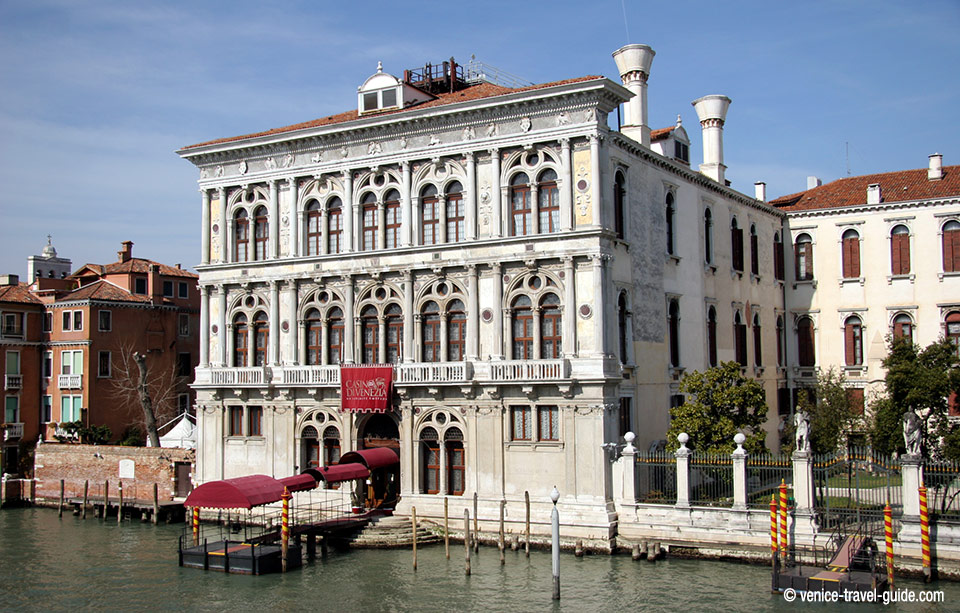Ca' Vendramin Calergi is a palace on the Grand Canal in the sestiere of Cannaregio. The architecturally distinguished building was the home of many prominent people through history. Currently, it is home to the Venice Casino and the Wagner Museum.
Ca' Vendramin Calergi is remembered as the place where composer Richard Wagner died. Other names by which it is known include: Palazzo Vendramin Calergi, Palazzo Loredan Vendramin Calergi, and Palazzo Loredan Griman Calergi Vendramin. Located on the Grand Canal, it's the first great palace of the Venetian Renaissance. The palace was built by request of Andrea Loredan in 1481 and its construction ended in 1509 on a project of the architect Mauro Codussi. The palace takes on one of the owners' names, Vittorio Calergi, and from its successors, the Vendramin family. It was during that period that the palace had its major glory. The Calergi extended it in 1614 and had the white wing, that delimits the garden, built. The facade is splendidly erected on the Grand Canal and although it's in classical style it gives a sense of light transparency and clearness of its lines. In 1882, the musician Richard Wagner was given hospitality in the mezzanine floor of the white wing where he worked on the Parsifal score until his death.
Ca' Vendramin Calergi History
Ca' Vendramin Calergi was designed in the late 15th century by Mauro Codussi, architect of Chiesa di San Zaccaria and other noteworthy churches and private residences in Venice. Construction began in 1481 and was finished after his death by the Bottega dei Lombardo in 1509. The twenty-eight-year period it took to complete construction is considered short based on the technology available at that time.
The spacious Renaissance-style palace stands three-stories high with direct access to the Grand Canal available by gondolas. The beauty and balance of the building's façade are exceptional. Classically inspired columns divide each level facing the canal. Two pairs of tall French doors divided by a single column topped by arches and a trefoil window rest above the doors on the piano nobile and upper levels. Opulent paintings, sculptures, and architectural details originally filled the building's interior. Baroque master Mattia Bortoloni decorated the ceilings of many rooms. The palace is locally known by the nickname Non Nobis Domine (Not unto us, O Lord) from Psalm 113:9, which is engraved in the stone under a ground-floor window.
Andrea Loredan, a connoisseur of the fine arts, commissioned the palace, which was paid for by the doge, Leonardo Loredan. In 1581, the Loredan family suffered financial difficulties and sold it for 50,000 ducats to Julius, Duke of Brunswick-Lüneburg, who had deep affection for Venice. However, the duke kept it only two years before selling it to Guglielmo I Gonzaga, Marquis of Mantua, who then sold it to Vittore Calergi, a Venetian noble from Heraklion on the island of Crete. Calergi greatly expanded the building in 1614 with a large addition by architect Vincenzo Scamozzi called the "White Wing" which included windows overlooking a garden courtyard. The addition was demolished in 1659 and rebuilt the following year. In 1739, the palace was inherited through marriage by the Vendramins, a powerful patrician family of merchants, bankers, religious leaders, and politicians, who owned it for more than a century.
In 1844, Caroline Ferdinande of Bourbon-Two Sicilies, the Duchess of Berry, and her second husband, Ettore Carlo Lucchesi-Palli, Duke della Grazia, purchased Ca' Vendramin Calergi from the last member of the Vendramin family line. In the turmoil of the Risorgimento, they were forced to sell the palace to Caroline's grandson, Henry (Enrico), Count de' Bardi, and many of its fine works of art were auctioned in Paris. Count de' Bardi and his wife Infanta Adelgundes and the related Dukes of Grazia maintained the home and hosted many famous names of the day. In 1937, the last of the Grazia nobles, Count Lucchesi-Palli, sold it to Giovanni Volpi, Count of Misurata, who remodeled the living quarters and turned it into a Center for Electromagnetic and Electrical Phenomena.
The City Council of Venice purchased Ca' Vendramin Calergi in 1946. Since 1959, it has been the winter home to the celebrated Venice Casino (Casinò di Venezia).
Map of Ca' Vendramin Calergi (Casino)
AddressAddressRoma de L'oca, 2040
30121 Venezia, Italia
